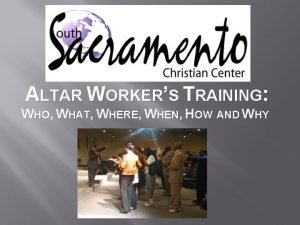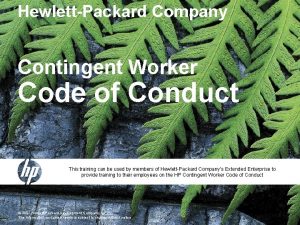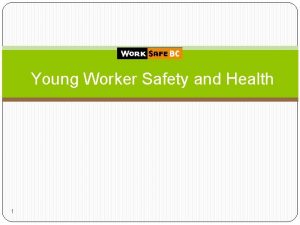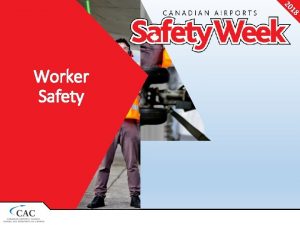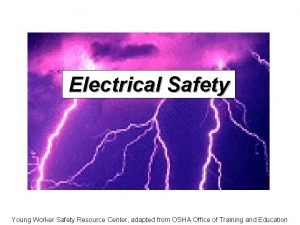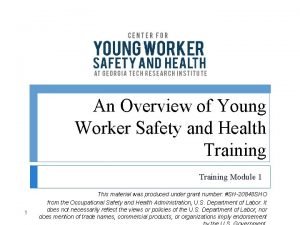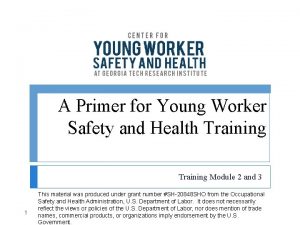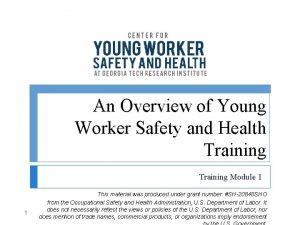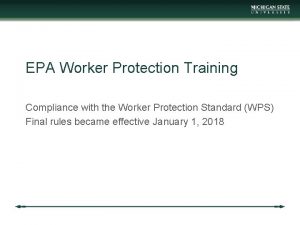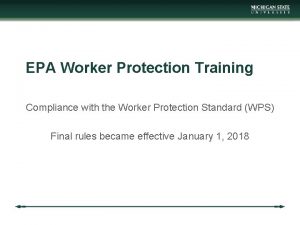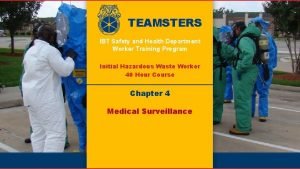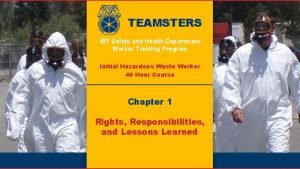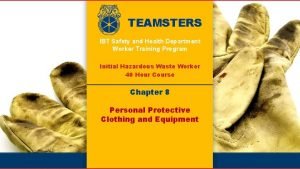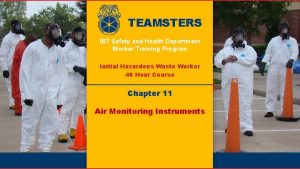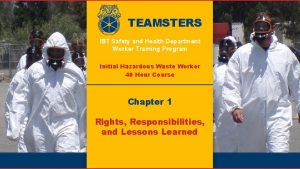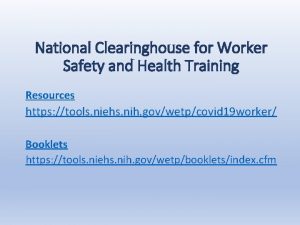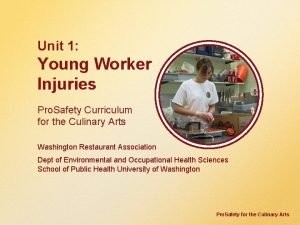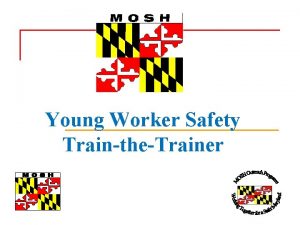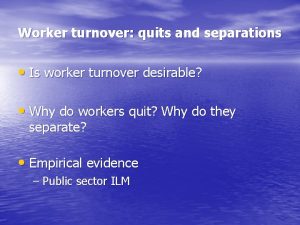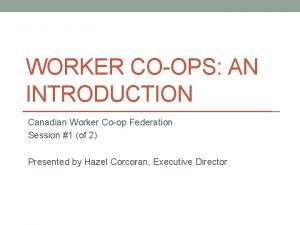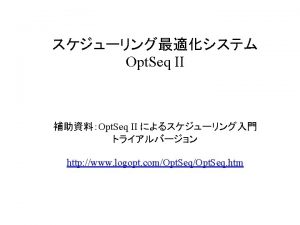Young Worker Safety and Health Training for the







































- Slides: 39

Young Worker Safety and Health Training for the Cosmetology Industry Training Module 5 1 This material was produced under grant number SH-22227 -11 from the Occupational Safety and Health Administration, U. S. Department of Labor. It does not necessarily reflect the views or policies of the U. S. Department of Labor, nor does mention of trade names, commercial products, or organizations imply endorsement by the U. S. Government.

Acknowledgement of Sources http: //www. cdc. gov/niosh/talkingsafety/ Introduction to OSHA http: //www. osha. gov/dte/outreach/construction_generalindustry/teachingaids. html Work Safe, Work Smart: Health and Safety Awareness for Working Teens curriculum. University of Washington: Dept. of Environmental and Occupational Health Sciences. Washington State Dept. of Labor and Industries. OSHA’s 11 – An OSHA 10 Hour General Industry Curriculum: University of Washington: Dept. of Environmental and Occupational Health Sciences. Washington State Dept. of Labor and Industries. 2 Center for Young Worker Safety and Health at Georgia Tech Research Institute

Course Agenda Introduction Bloodborne Pathogens and Infection Control Chemical Safety Hazard Communication Respiratory Protection Ergonomics 3 Center for Young Worker Safety and Health at Georgia Tech Research Institute

Tying it All Together 4 The Puzzle piece represents an activity that participants can do individually or as a group The Movie reel represents ways to integrate media into training The Microphone represents ways to encourage participation Center for Young Worker Safety and Health at Georgia Tech Research Institute

Did You Know? 20% hairdressers have to leave their profession due to health problems such as allergies and dermatitis (a skin condition) 30% of the nearly 3, 000 chemicals used in cosmetology are classified by the US government as toxic substances Source: New York Times Magazine; 7 March 1993 5 Center for Young Worker Safety and Health at Georgia Tech Research Institute

Beauty Comes at a Price…. Exposure to hazardous chemicals Risk of infection Repetitive motion injuries Burns/cuts/scratches Noise Stress 6 Center for Young Worker Safety and Health at Georgia Tech Research Institute

Chemical Safety and Hazard Communication Information Provided under OSHA Susan Harwood Capacity Building Grant: #SH-20848 SHO 7

Working with Chemicals Skin and respiratory disorders may develop from working with allergenic or irritating materials Examples include: 8 Absorption of chemicals through the skin from handling products. Inhalation of chemicals and dusts – examples include: spraying aerosol products, working with powder products, or shaping/filing acrylic nails. Ingestion of chemicals when holding clips, combs, or other tools in the mouth when working. Center for Young Worker Safety and Health at Georgia Tech Research Institute

Tips for Working with Chemicals Always read the MSDS sheets for the chemicals and products used Choose protective gloves that are appropriate for the chemical exposures Wash hands with soap and water after removing gloves or handling products Wear eye protection when mixing chemicals Do NOT mix chemicals or products unless manufacturer directions specify Always keep containers closed when not in use REMEMBER: Dilutions of cleaning and sanitation products should be made fresh daily (or as specified by the manufacturer). 9 Center for Young Worker Safety and Health at Georgia Tech Research Institute

Hazard Communication Who’s Covered: What’s Required: Chemical manufacturers Importers and distributors Employers that use chemicals ‘use’ means to package, handle, react, or transfer. What about contractors? Are you leasing or renting a station? Site specific written program Chemical inventory MSDSs Labeling Non-routine tasks Contractors Training Center for Young Worker Safety and Health at Georgia Tech Research Institute

Labeling Manufacturer's Containers • • • Chemical identity Hazard warnings Name, phone#/address Equipment Needing Labeling: Spray bottles Instrument disinfecting trays and containers In-Facility Containers • • Chemical identity Hazard warnings Image: Example of a labeling system used to identify hazardous properties of chemicals. Center for Young Worker Safety and Health at Georgia Tech Research Institute

Training and Material Safety Data Sheets One for each hazardous chemical Available to employees at all times Include the most • • • current information Review MSDSs Archive MSDSs that are no longer in use • Keep for 30 years Must Cover: • • The Standard Locations of MSDS and Program Contents of the Written Program Labeling System Hazards of Chemicals Protection Measures Detecting Releases Document This Training Center for Young Worker Safety and Health at Georgia Tech Research Institute

Breaking News- Case Study Exercise 1. 2. Read News Release Article, MSDS, and Hazard Alert Discussion Points: What have OSHA’s investigations found? What is formaldehyde and how can it affect my health? 13 What other names are used formaldehyde? How would I know if the product I’m using could expose me to formaldehyde? What should salons do to protect their workers? Center for Young Worker Safety and Health at Georgia Tech Research Institute

Prevention Strategies Examples: • Install a ventilation system to remove vapors from nail polish and removers • Substitute products with safer chemicals Examples: • Train employees on proper chemical mixing technique • Provide MSDSs for all chemicals and products Example: • Disposable gloves • Safety glasses or goggles • Apron 14 Remove/Substitute/Isolate the hazard Improve Work Policies & Improve Procedures Use Protective Clothing & Use Equipment Center for Young Worker Safety and Health at Georgia Tech Research Institute

Respiratory Protection in the Cosmetology Industry Information Provided under OSHA Susan Harwood Capacity Building Grant: #SH-20848 SHO 15

Respiratory Protection Is a filtering face piece a respirator? How about a one-strap mask? How about a two-strap mask? What about a surgical mask? Why would you wear a respirator? Center for Young Worker Safety and Health at Georgia Tech Research Institute

What is a Respirator? Respirators are devices that protect workers from inhaling harmful airborne substances. Some respirators also ensure that workers do not breathe air that contains dangerously low levels of oxygen (O 2). (OSHA’s Small Entity Compliance Guide, 2011) Center for Young Worker Safety and Health at Georgia Tech Research Institute

Respiratory Protection in the Cosmetology Industry Concern: Dust exposure when working with acrylic nails Option 1: Option 2: N-95 Surgical Respirato Mask r 18 Center for Young Worker Safety and Health at Georgia Tech Research Institute

Bloodborne Pathogens and Infection Control Information Provided under OSHA Susan Harwood Capacity Building Grant: #SH-20848 SHO 19

What’s a Pathogen? Viruses Cold & Flu Hepatitis B & C HIV Bacteria 20 Impetigo Staph infections Center for Young Worker Safety and Health at Georgia Tech Research Institute

Bloodborne Pathogens At work, most biological pathogens are transmitted from: Accidental puncture from a contaminated sharp object Contact between broken skin and infected body fluids Contact between mucous membranes and infected body fluids REMEMBER: Blood or body substances do not have to be visible for an infection to be transmitted 21 Center for Young Worker Safety and Health at Georgia Tech Research Institute

Exposure Routes Shaving Tweezing Waxing Piercings Manicure/Pedicure Tattooing Electrolysis Skin esthetician (injections) Massage/Facials Cleaning of equipment Center for Young Worker Safety and Health at Georgia Tech Research Institute and tools 22

Prevention Strategies Example: single-use, disposable equipment (razors, make-up brushes, nail scrub brushes) Examples: • Training on infectious disease and transmission • “Universal Precautions” rule • Handwashing rules • Hepatitis B vaccination Example: • Disposable gloves for use during procedures and cleaning equipment 23 Remove/Substitute/Isolate the hazard Improve Work Policies & Improve Procedures Use Protective Clothing & Use Equipment Center for Young Worker Safety and Health at Georgia Tech Research Institute

Prevention Strategies Autoclave Heat & Steam Good for objects Ultrasonic cleaner Vibration & disinfectant Decontamination vs. Disinfection vs. Sterilization 24 Hospital grade disinfectants “Quats” (quaternary ammonium compounds) Glutaraldehyde Ethyl alcohol Bleach solutions Center for Young Worker Safety and Health at Georgia Tech Research Institute

Proper Glove Removal Practice Center for Young Worker Safety and Health at Georgia Tech Research Institute

Hand washing Hand sanitizer does not remove harmful bacteria or viruses as well as washing hands with soap and water for 20 seconds Hand sanitizer is NOT a replacement for washing hands with soap and water! Hand sanitizer does NOT remove chemicals from your hands 26 Center for Young Worker Safety and Health at Georgia Tech Research Institute

Ergonomics in the Cosmetology Industry Information Provided under OSHA Susan Harwood Capacity Building Grant: #SH-20848 SHO 27

High prevalence of musculoskeletal complaints: Awkward, prolonged working postures Elevated arms Bent back Bent head Example: washing, haircutting and styling tasks, manicure/pedicure Causes extreme positions of the forearm and wrists to occur frequently, increasing the risk of tendon-related disorders Repetitive movements Sometimes forceful movements of the hands and fingers 28 Center for Young Worker Safety and Health at Georgia Tech Research Institute

An Exercise in Strength Figure 1 Figure 2 Figure 3 29 Center for Young Worker Safety and Health at Georgia Tech Research Institute

What is Ergonomics? Fitting the task to the person Physical abilities of the human body & Limitations of human body B E S T F I T Work tasks Tools and Equipment The job environment Center for Young Worker Safety and Health at Georgia Tech Research Institute

Questions to ask yourself… Are you gripping or squeezing any of the implements too tightly? What types of repetitive motions are you doing throughout the day? Are you holding your arms away from you body for extended periods of time? Do you find yourself bending forward or twisting into awkward positions to reach your client? 31 Center for Young Worker Safety and Health at Georgia Tech Research Institute

Prevention Strategies Example: • Use ergonomically designed shears- with offset blade handles and finger rests Examples: • Hold wrists in straight, neutral position • Allow for stretching intervals • Keep neck and back straight • Keep arms at your side • Stand upright and adjust chair height • Palm the shears and/or razors Example: • Choose appropriate footwear that is supportive and comfortable 32 Remove/Substitute/Isolate the hazard Improve Work Policies & Improve Procedures Use Protective Clothing & Use Equipment Center for Young Worker Safety and Health at Georgia Tech Research Institute

Other Safety & Health Concerns Information Provided under OSHA Susan Harwood Capacity Building Grant: #SH-20848 SHO 33

Other Safety Concerns Always use a guard when working with a razor, unless specifically directed. Consider eye protection to protect from flying objects (such as when clipping nails). Disconnect equipment and tools when not in use. Make sure to not overload outlets Inspect electrical equipment for frayed wires or connections. Keep cords away from high traffic areas where they could pose a trip hazard. 34 Center for Young Worker Safety and Health at Georgia Tech Research Institute

Your Right to a… The creation of OSHA provided workers the right to a safe and healthful workplace. Section 5(a)(1) of the OSH Act states: “Each employer shall furnish to each of his employees employment and a place of employment which are free from recognized hazards that are causing or are likely to cause death or serious physical harm to his employees. " www. osha. gov or call: 1 -800 -321 -OSHA 35 Center for Young Worker Safety and Health at Georgia Tech Research Institute

Building Resources: Cosmetology Specific http: //digitalcommons. ilr. cornell. edu/cgi/viewcontent. cgi? ar ticle=1006&context=manuals http: //www. deir. qld. gov. au/workplace/subjects/hairdressing /guide/index. htm http: //www. lohp. org/publications/cosmo_hazards. html http: //www. ilo. org/safework_bookshelf/english? content&nd =857171213 http: //unionsafe. labor. net. au/hazards/106014706721942. ht ml 36 Center for Young Worker Safety and Health at Georgia Tech Research Institute

Building Resources National Resources 37 Occupational Safety and Health Administration (OSHA) www. osha. gov and http: //www. youth 2 work. gov/ National Institute of Occupational Safety and Health (NIOSH) http: //www. cdc. gov/niosh/topics/youth/ Youngworkers. org http: //www. youngworkers. org/home. htm *The California Resource Network for Young Workers’ Health and Safety and home of The National Young Worker Safety Resource Center United States Department of Labor, Wage and Hour Division (WHD) Youth Rules! http: //www. youthrules. dol. gov/teens/default. htm National Children’s Center for Rural Agricultural Health and Safety http: //www. marshfieldclinic. org/nccrahs/ Gulf Coast Safety Institute www. com. edu/gcsi Center for Young Worker Safety and Health at Georgia Tech Research Institute

Building Resources Georgia Local Resources Georgia Department of Education http: //www. doe. k 12. ga. us/ http: //www. gadoe. org/ Georgia Department of Education: Career, Technology and Agricultural Education http: //www. gadoe. org/ci_cta. aspx Skills. USA www. skillsusageorgia. org and www. skillsusa. org Georgia Technology Student Association www. gatsa. org Georgia Engineering and Technology Education Association www. getea. org Georgia Health Occupations Students of America www. georgiahosa. org Construction Education Foundation of Georgia www. cefga. org Trade and Industrial Educators of Georgia http: //tiega. org/ MAGIC "Mentoring a Girl in Construction" , Inc. Summer Camp Program www. mentoringagirlinconstruction. com Project Safe Georgia www. projectsafegeorgia. org American Society of Safety Engineers (ASSE)- Georgia Chapter http: //georgia. asse. org/ Georgia Local Section- American Industrial Hygiene Association (GLS-AIHA) http: //www. georgiaaiha. org/ 38 Center for Young Worker Safety and Health at Georgia Tech Research Institute

For More Information Email: youngworker@gtri. gatech. edu Website: www. youngworker. gatech. edu Twitter: @youngworker Facebook: http: //www. facebook. com/#!/Young. Worker. at. GTRI 39 Phone: 404 -407 -8089 Address: Center for Young Worker Safety and Health at GTRI 260 14 th Street Atlanta, GA 30332 -0837 Center for Young Worker Safety and Health at Georgia Tech Research Institute
 Family support worker qualifications
Family support worker qualifications Young worker readiness certificate
Young worker readiness certificate Safety care training
Safety care training Altar worker job description
Altar worker job description Contingent worker code of conduct
Contingent worker code of conduct Formuö
Formuö Typiska drag för en novell
Typiska drag för en novell Tack för att ni lyssnade bild
Tack för att ni lyssnade bild Vad står k.r.å.k.a.n för
Vad står k.r.å.k.a.n för Shingelfrisyren
Shingelfrisyren En lathund för arbete med kontinuitetshantering
En lathund för arbete med kontinuitetshantering Underlag för särskild löneskatt på pensionskostnader
Underlag för särskild löneskatt på pensionskostnader Personlig tidbok fylla i
Personlig tidbok fylla i Sura för anatom
Sura för anatom Förklara densitet för barn
Förklara densitet för barn Datorkunskap för nybörjare
Datorkunskap för nybörjare Boverket ka
Boverket ka Debattartikel struktur
Debattartikel struktur Magnetsjukhus
Magnetsjukhus Nyckelkompetenser för livslångt lärande
Nyckelkompetenser för livslångt lärande Påbyggnader för flakfordon
Påbyggnader för flakfordon Kraft per area
Kraft per area Svenskt ramverk för digital samverkan
Svenskt ramverk för digital samverkan Jag har gått inunder stjärnor text
Jag har gått inunder stjärnor text Presentera för publik crossboss
Presentera för publik crossboss Teckenspråk minoritetsspråk argument
Teckenspråk minoritetsspråk argument Kanaans land
Kanaans land Klassificeringsstruktur för kommunala verksamheter
Klassificeringsstruktur för kommunala verksamheter Luftstrupen för medicinare
Luftstrupen för medicinare Bästa kameran för astrofoto
Bästa kameran för astrofoto Centrum för kunskap och säkerhet
Centrum för kunskap och säkerhet Byggprocessen steg för steg
Byggprocessen steg för steg Mat för unga idrottare
Mat för unga idrottare Verktyg för automatisering av utbetalningar
Verktyg för automatisering av utbetalningar Rutin för avvikelsehantering
Rutin för avvikelsehantering Smärtskolan kunskap för livet
Smärtskolan kunskap för livet Ministerstyre för och nackdelar
Ministerstyre för och nackdelar Tack för att ni har lyssnat
Tack för att ni har lyssnat Referatmarkeringar
Referatmarkeringar Redogör för vad psykologi är
Redogör för vad psykologi är



